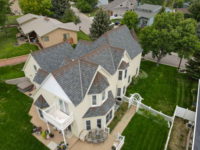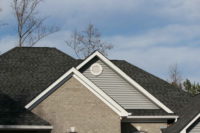Asphalt Roof Protects Family From The Elements With Style and Consistency
The Apex of Funtion & Design

The Vankregten residence in Mill Creek, Wash., received the 2013 Quality Asphalt Roofing Case-Study (QARC) Silver Award from the Asphalt Roofing Manufacturers Association (ARMA). The award honors the top asphalt roofing projects in North America for their beauty, affordability and reliability. Photo by Jarod Trow of Trow Photography. Photo courtesy of ARMA.
Most homeowners will purchase a roof only once in their lifetime. As this is a decision that will impact the look and performance of a home for as long as a homeowner may live there, it is essential to make the right choice the first time around. While four out of five homeowners choose asphalt roofing over other materials, there are many factors that contribute to this important investment decision, including beauty: the right look and style that fits a home and conforms to the neighborhood; affordability: a cost-effective roofing system that offers superb value; and reliability: a roof that is durable and long lasting.
However, there are some factors beyond a homeowner’s control. For one family living in a bucolic, upscale community called Evergreen in Mill Creek, Wash., selecting the right roofing system meant not only that it needed to look good and perform well at the right price, but it also had to meet the high standards of the local homeowners association.
So when it came time to install a new roof on their home, the Vankregten family had to abide by the Mill Creek Community Association’s (MCCA) strict guidelines. The roof that the family chose to install on their home would have to meet specific aesthetic, performance and durability requirements predetermined by the homeowners association. According to Chris Howard of Chris Howard Roofing, the roofing contractor hired for this residential re-roofing project, these are some of the most stringent roofing requirements in the region.
The Vankregten family also had some of their own personal requirements for the roof. First and foremost, the family wanted a roof that would last a long time and require as little maintenance as possible. The new roof also needed to resemble the existing cedar shake roof and accent the color of the home, which features extensive brickwork on the siding and chimney. Asphalt shingles offered a wider range of colors and styles, as well as an easier installation process than cedar shake.
Living in the Northwest, the family did not want a roof that was noisy when it rained, so metal was out of the question. They also wanted a product that would lessen the impact of algae growth, which can be a problem in the area and afflicts some neighborhood roofs.
Making a Long-Term Decision
The family decided on an asphalt roof and chose the PABCO Paramount Advantage shingle, a dimensional shingle designed to emulate the look of wood. According to Howard, the shingle met or exceeded all of the requirements laid out by the MCCA.
“The shake-like appearance of this shingle was inspired by cedar shake roofs, which were popular among homeowners and in subdivisions in the 1970s and 1980s,” said Kevin Olson, manager, customer service and marketing, PABCO Roofing Products. “Homeowners associations have moved away from wood shakes, often because of fire concerns, but asphalt shingles can be designed to resemble that style with a Class A fire rating.”
In addition to the desirable aesthetics, unlike traditional wood shakes, the system met the safety requirements of UL Class A fire protection, and the shingle was also manufactured to the stringent performance standards of ASTM D3462, according to Olson.
One necessary design feature that the shingle had to offer was algae protection. The shingle chosen was treated with an additive that helps with algae resistance.
Mill Creek is located near the coast, and many homes in the area suffer from roof discoloration caused by algae and moss. “It is an important feature to have on a shingle if your area is known to have algae. Algae spores are airborne, so it can easily spread from roof to roof,” Olson continued.
The Installation
Before installing the roof, Howard said he was confident in both his ability to get the job done and in the ability of the asphalt shingles to provide protection for the home against the harsh Northwestern weather.
“Asphalt shingles can be installed in any climate, although it is ideal to install them in moderate conditions,” said Howard. “The asphalt shingle is a great roofing choice for this part of the Pacific Northwest.”
The roof deck type was a half-inch CDX plywood installed over skip sheeting using 3-inch, hot-dipped galvanized nails. The roof ventilation included soffit vents to provide for air intake and a combination of 6-inch metal air and ridge vents. Ventilation needs vary from home to home, but proper ventilation can often help reduce moisture and heat buildup in an attic.
Other roofing system components included installing a No. 30 ASTM underlayment, and ice and water shields in the valleys and around all roof penetrations. A starter metal, drip edge, roof to wall, valley metal, pan flashing and step flashing were all used on this project. All of the step flashing was 26 gauge and painted to coordinate with the color of the roof. The chimneys were counter flashed using real mortar, so that no caulk was required. Permanent roof anchors were also installed for future maintenance and safety.
“All flashing details are straightforward and quite simple to perform using asphalt shingles,” Howard said. “Skylights, chimneys, plumbing boots, air vents and edges are easy to roof around once you know the basic flashing techniques. When installing metal, slate or tile roofs, there is a lot more detail that needs to go into it, and many more things can go wrong.”
Years of Protection
Every year, the Asphalt Roofing Manufacturers Association (ARMA) honors the top asphalt roofing projects in North America for their beauty, affordability and reliability through its Quality Asphalt Roofing Case-Study (QARC) Awards program. QARC is designed to recognize architects, contractors and specifiers who use asphaltic roofing materials on low-slope and steep-slope building projects. Unique design aesthetics, craftsmanship and versatility are important factors in the judging criteria.
In 2013, the MCCA residence won the QARC Silver Award. The NOAA Building in La Jolla, Calif., won the Gold Award, and the American Life & Accident Insurance Company building in Louisville, Ky., took home the Bronze. ARMA is currently accepting submissions for the 2014 QARC Awards.
“The real advantage to asphalt shingles is the limitless ways to make the design needs meet the functional needs,” Olson said. “High-performance requirements and particular aesthetics can both be met in a wide array of various asphalt shingle colors and designs. This adaptability is why so many homeowners choose asphalt shingles, such as the owners of the MCCA residence did to their great benefit.”
Since the Vankregten residence was completed, many other homes in the neighborhood have made the switch from cedar shake to asphalt shingles similar to the ones used on this home. For homeowners who need to meet a high design standard or strict code, asphalt shingles can provide a variety of styles, choices and dependability.
For more information, visit www.asphaltroofing.org.
Looking for a reprint of this article?
From high-res PDFs to custom plaques, order your copy today!





